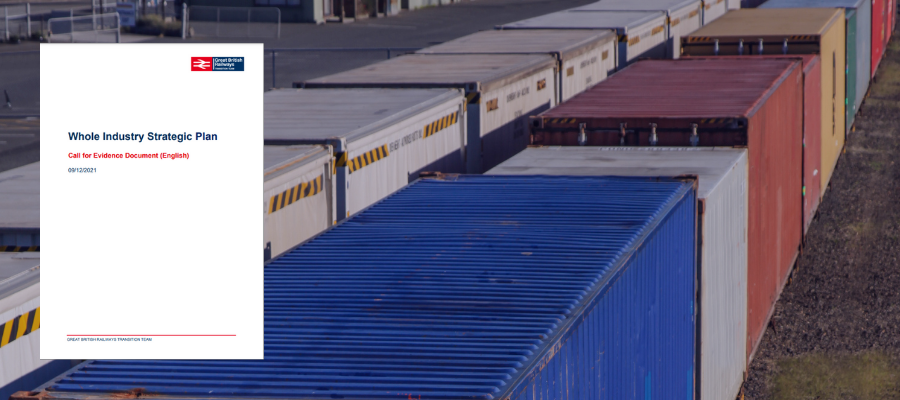🕒 Article read time: 2 minutes
The future of rail freight: the Whole Industry Strategic Plan

The development of a Whole Industry Strategic Plan (WISP) for rail presents a unique opportunity to future proof our railways and address the key issues that have been curtailing their growth for decades, Logistics UK has said.
In February 2022, the business group submitted its response to the Great British Railways Transition Team’s call for evidence to help develop this strategy. Commissioned by the Secretary of State for Transport, the WISP will detail five long-term strategy objectives for the rail industry: meeting customers’ needs; delivering financial sustainability; contributing to long-term economic growth; levelling up and connectivity; and delivering environmental sustainability.
DELIVERING ENVIRONMENTAL SUSTAINABILITY
The environmental benefits of utilising rail over other freight modes are well documented – for example, rail reduces CO2 emissions by up to 76% compared to road – but the network needs to be decarbonised completely, predominately through electrification. The development of the WISP has a critical role to play in bringing forwards long-term, affordable plans for electrification of the network which will create the backbone for a net-zero rail network.
In addition to transitioning rail freight to a low carbon mode, as the earth’s temperature continues to rise, climate change resilience must be built into the network. The Climate Adaptation Committee’s Independent Assessment of UK Climate Risk notes that the 2018 heatwave led to a 40-50% increase in rail asset failure, and that 3,500km of rail length in areas are at significant risk of surface water flooding. The report calls for engineered solutions in both road and rail, such as re-surfacing, changes in materials used, and earthworks and vegetation management to ensure services can continue effectively despite the impact of rising temperatures.
DELIVERING FINANCIAL SUSTAINABILITY
As a private sector enterprise, rail freight operations rely on a sound business case to run services and attract investment; at present, the comparatively high cost-base of rail can make it challenging to deliver financially sustainable services. The rail charging regime is complex, and because freight operators can move several different products for customers in the same load, and often have both diesel and electric traction, they are subject to up to four separate charges: freight-specific charges for certain commodities; variable user charges; electrification asset user charges and traction electricity charges.
Mags Simpson, Logistics UK’s Head of Public Engagement, said: “Logistics UK is pleased that Great British Railways (GBR) – the replacement for Network Rail – will be reviewing charging mechanisms; to increase the use of rail for freight, we are calling on the group to ensure there is a transparent and fair charging regime, balanced by clear independent oversight.”
LEVELLING UP AND CONNECTIVITY
Rail freight has a proven role in supporting the “levelling up” agenda – the government’s plan to improve economic and social opportunities across the country. Research by the Rail Delivery Group shows that the rail sector’s benefits are “dispersed from the South of England through the industrial heartland of the Midlands, Wales and North England up into the central belt of Scotland and beyond”. Rail freight facilities such as intermodal interchanges, as well as rail-linked industrial facilities such as aggregates, power stations, construction sites and ports, all help unlock activity and employment in local areas. Inland rail intermodal interchanges are a clear example of added economic value, with developments such as East Midlands Gateway, Daventry International Rail Freight Terminal, and East Midlands Gateway acting as catalysts to economic activity and development in the region.
“We are urging GBR to seek out existing economic benefit analysis of these projects,” Simpson said, “or if required, commission new work to assess this to ensure its value is understood and captured in planning scenarios.”
FUTURE DEVELOPMENT OF RAIL FREIGHT
A key challenge for the rail sector is to accommodate the pent-up demand for freight rail services through the provision of capacity and by enabling operators and intermediaries to deliver reliable, value-add services to customers; for example, Network Rail forecasts that if capacity was unconstrained, there could be an increase of 32% in tonnes (46% in tonne km), with intermodal tonnes doubling, for 2033/34.
“Logistics UK is calling for GBR to review this data and ensure that addressing the capacity limitations for freight services is a key objective in its plans,” Simpson said.
The international rail freight sector is under-utilised with international flows accounting for just 2% of the domestic market. There has been a very welcome development recently with GetLink launching a daily unaccompanied freight service, and Logistics UK encourages GBR to review inland rail connection facilities to enable this route to grow. There are many other areas where GBR could encourage rail freight growth, for example the express parcel sector, the waste market, and the construction sector.
For all core rail freight markets, the government should deliver the Strategic Freight Network (SFN) package of measures, which will boost rail capacity on the key freight market routes. To support the intermodal market, which has considerable growth potential, there are several SFN projects that GBR should prioritise, such as the Trans Pennine Route Upgrade committed in the Integrated Rail Plan, and Southampton Train Lengthening, among others.
“The development of WISP and the creation of GBR is a golden opportunity to transform GB’s railways,” Simpson said, “to ensure its use is maximised by businesses and consumers in the decades to come, while future proofing the mode against climate change and other challenges. Logistics UK will be working with GBR throughout the development of the WISP to ensure the voices of our members are heard.”
*www.logistics.org.uk/rail
Published On: 24/02/2022 16:00:32

Comments Section
If you are a Logistics UK member login to add comments.